Marlin 17VS
by Technical Advisor Brendan Atkinson
Hunter 5
Two completely new cartridges have been released in recent times - the .300WSM, a review of which appeared in the July Australian Shooter, and, at the other end of the cartridge scale, the .17 Hornady Rimfire Magnum. The latter has sent shock waves throughout the shooting world, causing companies to rush to produce enough rifles to fill orders and the Hornady factory to vastly increase production of this tiny cartridge. At the time of writing, Hornady is the only company producing ammunition for this calibre.
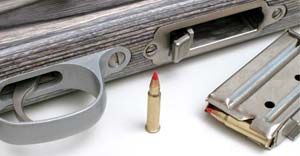
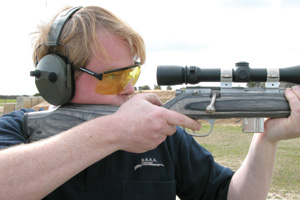
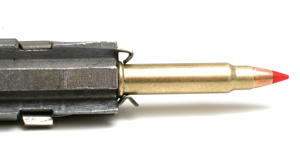
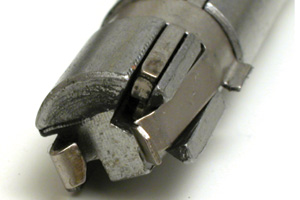
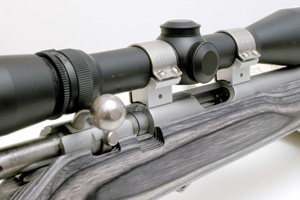
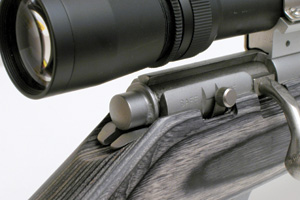
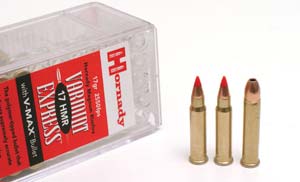 The .17HRM is a .22 rimfire magnum case necked down to .17 calibre. The
.172-inch diameter V-Max bullet is a 17-grain boat-tail hollow point
tipped with polycarbonate. The powder charge is 5.4 grains of an
undisclosed type and the bullet is heavily crimped into the case. The
velocity is claimed to be 2550fps from a 22-inch barrel.
The .17HRM is a .22 rimfire magnum case necked down to .17 calibre. The
.172-inch diameter V-Max bullet is a 17-grain boat-tail hollow point
tipped with polycarbonate. The powder charge is 5.4 grains of an
undisclosed type and the bullet is heavily crimped into the case. The
velocity is claimed to be 2550fps from a 22-inch barrel.
The first rifles chambered in this calibre to reach Australia were in a batch of Marlins imported by Nioa Trading in Queensland. At the time of writing this review all the rifles had been sold, with a large waiting list looming.
For this review I was supplied with the stainless steel version, designated the Marlin 17VS. This Marlin continues the modern trend of varmint rifles in that it utilises a laminated wooden stock protected with a Mar-Shield coating. It is finished in an attractive grey/black colour scheme, which complements the matte stainless steel metal work. Nickel-plated sling swivels are supplied as standard, as is a rubber butt pad.
The action appears to be identical to the Model 882SSV, which is fitted to rifles chambered for the .22 rimfire magnum cartridge. The nickel-plated clip magazine will hold and feed seven rounds. A thumb-operated safety catch is provided for those who believe in them and a red cocking indicator can be seen at the back of the bolt. The varmint weight stainless steel barrel is 22 inches in length with a right-hand one turn in nine twist. No open sights are fitted, but the receiver is grooved and one-inch diameter scope ring mounts are included with each rifle. Weaver mounts were supplied with the test rifle.
Some comment must be made about the trigger, which on the test rifle was extremely heavy. Some of the shooters who were offered a shot actually checked to see if the safety catch was engaged when their first ‘pull’ did not fire the rifle. This can be modified with some careful attention and the use of a lighter trigger spring, but this should only be carried out by an experienced gunsmith, who will reduce the let-off to a more manageable weight. It is definitely worth spending a few dollars to have this done.
When conducting the review, ammunition for this calibre was in very short supply. Some gun shops that were holding rifles for customers had only just enough to supply to these purchasers. Fortunately, Rob Paradis of Adelaide Gun Shop was able to supply me with 100 rounds of his personal stock to do some testing.
I placed targets at 50 yards, 100 yards and 150 yards and the day was near perfect for testing loads. A Leupold VX111 in 3.5-10x was fitted and the Marlin was shot from a bench rest.
Three shots were fired to ‘zero’ the rifle and then the barrel was thoroughly cleaned - no metal fouling was evident. Remember, this was a brand-new rifle and I was still in the ‘running in’ part of the program. Two five-shot groups were then fired at 50 yards, with a clean after each one. Under the benchrest measure they were scored at .586 and .488 - not bad for a new barrel. Moving out to 100 yards I fired a shot from a clean, cold barrel. Four more shots went down range on the same hold and I marvelled at a group that showed the first shot slightly high and the last four grouped into .390. Interestingly enough, the point of impact at 50 and 100 yards is identical. That makes this cartridge very handy in the field, as the same hold can be used out to about 120 yards for targets the size of a rabbit’s head. Several other groups at 100 yards were fired and all were under the one-inch mark. Very impressive, but how much further out could the little bullet hold its accuracy?
At 150 yards, groups opened up a bit, but were in the order of one and a half inches. At this range the wind sensitivity of the little 17-grain bullet is apparent, but this was to be expected. I did fire some shots at 200 yards, but for all practical purposes, I would suggest that humane shots on small targets be limited to no more than 175 yards.
The opportunity to put this to the test came when I was asked to cull some hares that were damaging a recent native tree replanting. Some 7000 small trees had been planted and the local hares thought dinner had been served. Shooting was done over a spotlight and many hares were taken at ranges from 80 yards out to about 150 yards. Interestingly enough, hits to the shoulder area killed instantly and the little bullets did not exit the bodies. With fox skins now worth money again, this might be something to consider.
I did attempt to whistle up some foxes in a rocky hills area, but although some were sighted, they were extremely reluctant to approach within range. A crow feeding on a lamb carcass was shot at about 135 yards and again the bullet did its job - the body appeared unmarked, not a feather out of place. The amazing hitting power of the .17HRM can be put down to the fact that the tiny bullet exits the muzzle revolving in excess of 3000 revs per second. The bullet literally explodes upon contact. There is some speculation that Hornady may produce ammunition loaded with a heavier bullet at about 2000fps - right now they are flat out keeping up with the current loading.
My overall impressions of this package are good. It gives the shooter almost double the range of a .22LR rimfire with a very accurate factory load. A big plus is that by .17 calibre standards, the muzzle blast is quite mild and this may be of some advantage for feral pest destruction on smaller properties where louder cartridges may cause some concern with neighbours. On the down side, ammunition is not cheap, retailing at about $27 per 50, but then again you would not use this rifle for casual plinking. The cheaper .22LR rimfire is much more suited to that.
The Marlin 17VS performed flawlessly throughout the test and, at about $875 retail, I believe it represents good value.
It would be remiss of me not to mention that 30 years ago an Australian came up with a cartridge very similar to the .17HRM. Arthur Langsford, owner of Myra’s Sports Store in Broken Hill, invented the .17-3000 ‘Tini-Mite’, which used seven grains of powder to propel a 20-grain bullet to 3000fps. The cartridge never really caught on with the public, as it was just too radical for its time. Sadly, Arthur is no longer with us, but I’m sure he would have had a wry smile at the success of the Hornady .17HRM.

